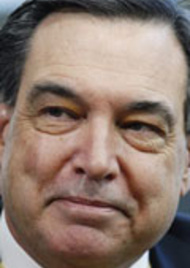By: Jon Wellinghoff with Ron Pernick

Part of a series of insights from leading smart-grid, clean-energy, and utility experts speaking at gridCONNEXT. Questions asked by Clean Edge managing director, author, and gridCONNEXT co-chair Ron Pernick.
Ron Pernick: As the head of the Federal Energy Regulatory Commission (FERC), perhaps more than any prior or subsequent chair, you led with an eye on the transition to a renewable energy (RE) and distributed generation (DG) future. What was the impetus for this drive?
Jon Wellinghoff: In a word: Efficiency. In the broadest sense, if we are to truly see the promise of competitive energy markets we need to ensure that those markets are as efficient as possible. In order to optimize efficiency, it is necessary to structure those markets in a manner that minimizes barriers to market participation by all reliable technologies capable of providing market services. When I first arrived at FERC is was evident that the historical market structure was primarily designed to incorporate traditional technologies such as central station fossil fuel and nuclear generation. Little thought had really been given to variable technologies like wind and solar, or distributed technologies like demand response, storage, distributed generation or energy efficiency. We changed that when I became Chairman of the agency. We leveled the playing field.
Pernick: What would you say has changed the most in the utility sector since you left FERC in November 2013?
Wellinghoff: Two things primarily: One is the price of renewable generation. It is now cost competitive with, and on a marginal cost basis, less costly than all traditional forms of generation. Coal and nuclear power cannot now compete on a cost basis with solar and wind. There is no contest
Pernick: For years we've seen pilot programs for smart grid technologies (often limited in scope or territory). What are some of the best examples of mass-market smart-grid utility programs that demonstrate tangible value to customers?
Wellinghoff: One of the best that I have worked on is one that is yet to be fully implemented. That is the Portland General Electric (PGE) Smart Grid Test Bed. This is a pilot to demonstrate a comprehensive load control strategy across three PGE substations covering over 20,000 customers. This “first of a kind” demonstration represents a leap forward in the relationship between customers and their energy providers. By providing customers with more control over their energy consumption and carbon footprint with the latest in control technology, PGE is on a path to building a model that energy providers everywhere can learn from and replicate.
Pernick: Your career has spanned working with both utilities and utility disrupters (solar companies, microgrid developers, etc.). How would you say the activities of utilities and disrupters are beginning to converge?
Wellinghoff: Utilities are now beginning to understand that disruption will occur with or without their participation. Thus, some utilities, like Green Mountain Power, are actively choosing to be part of that disruption in positive and constructive ways that strive to deliver the services to their customers that those customers demand. The best utilities are actively partnering with disrupters to create a
Pernick: For young professionals looking to support the current energy transition and growth of a modernized grid, what do you recommend? Which technology sectors/market activities do you believe offer the greatest opportunity over the next 10 to 20 years?
Wellinghoff: I recommend that they go to China. I just returned from China where I was engaged in extensive consultations with high officials from the Chinese government and State Grid. It was apparent to me that there is an interest

